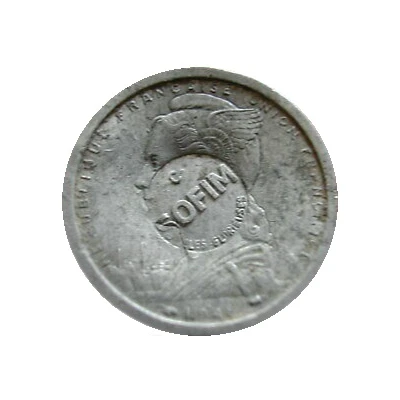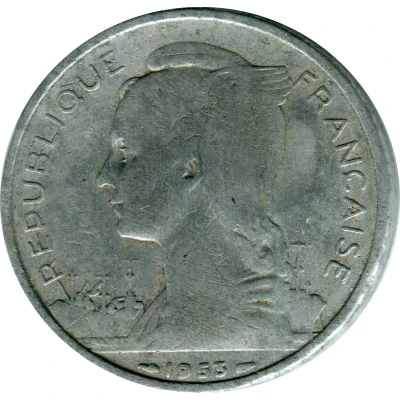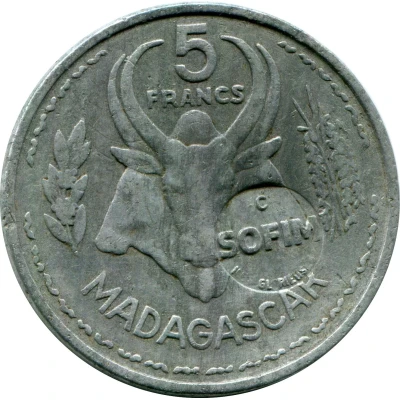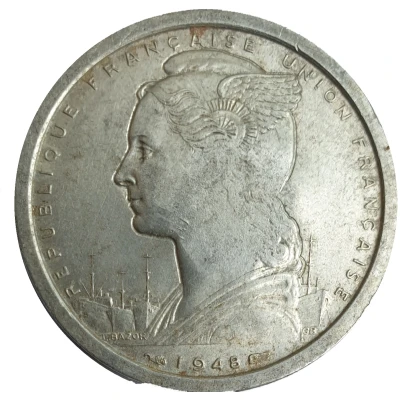
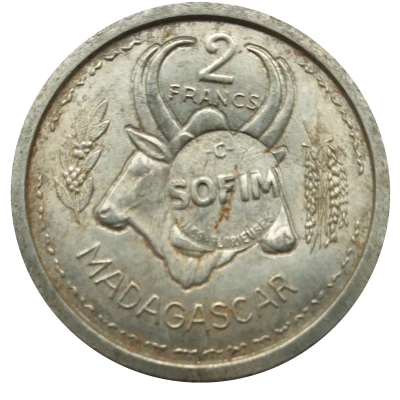

2 Francs SOFIM
1958 year| Aluminium | 2.2 g | 27 mm |
| Location | Glorioso Islands (Scattered Islands in the Indian Ocean) |
|---|---|
| Type | Trade tokens › Work encampment, mine and wage tokens |
| Year | 1958 |
| Value | 2 Francs (2 XPF) |
| Currency | CFP franc (1945-date) |
| Composition | Aluminium |
| Weight | 2.2 g |
| Diameter | 27 mm |
| Thickness | 1.9 mm |
| Shape | Round |
| Technique | Milled, Countermarked |
| Orientation | Coin alignment ↑↓ |
| Demonetized | Yes |
| Updated | 2024-11-14 |
| Numista | N#182076 |
|---|---|
| Rarity index | 94% |
Reverse
Round countermark:
-C-
SOFIM
ILES GLORIEUSES
On a 2 Francs Madagascar coin
Script: Latin
Lettering:
2 francs
-C-
SOFIM
ILES GLORIEUSES
MADAGASCAR
Engraver: Lucien Georges Bazor
Edge
Plain
Comment
From 1952 to 1968, SOFIM (Société Française des Iles Malgaches) operated copra and phosphate mines in the Éparses Islands, which include Juan de Nova and the Glorieuses Islands. The company was first managed by Hector Patureau, who obtained a concession to mine phosphate on Juan de Nova in March 1952. During this period, the first meteorological station ("La Goulette") was built. Following Madagascar's independence in 1960, SOFIM's concession was renewed for a further 25 years. The island was then inhabited by Mauritian and Seychellois workers, who exploited the guano deposit for SOFIM. During this period, the island's infrastructure underwent significant development: the first lighthouse was built in 1965-1966. Following a workers' revolt and a fall in phosphate prices (1968), SOFIM was dissolved on Juan de Nova. In an article published in 1973, Le Nouvel Observateur suggested that "the working and living conditions of the Mauritian and Seychellois workers were terrible (corporal punishment, imprisonment) and akin to a form of slavery", a claim which appears to have been subsequently denied. During the same period, in the Glorieuses Islands, SOFIM, commissioned by Jules Lauzier and then his brother Gaston, exploited copra until 1958, employing Malagasy workers.
Coins are found with two distinct countermarks: for the Îles Glorieuses, the round hallmark reads "C. SOFIM. ILES GLORIEUSES", the C supposedly standing for Coprah; for Juan de Nova, hexagonal hallmark "P. SOFIM. JUAN DE NOVA", the P supposed to stand for Phosphate.
The vast majority are Madagascar coins, while a smaller number are French coins of the period (from the French State to 1958) and rarer coins from La Réunion and colonial continental Africa.
